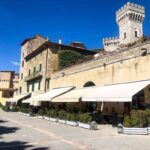San Casciano dei Bagni springs up among very thick woods of oaks, chestnuts and ancient pines. The picturesque medieval village is placed in the border between Umbria and Latium, it stands on the slope of the Cetona overlooking the Val di Paglia. Its territory shows the so called “calanchi”, big clay and sand erosions which make the landscape almost lunar.
The urban complex, clearly medieval, develops on a hill and shows a peculiar labyrinth of narrow roads winding around the church.
The development of the present historical centre of San Casciano, took place in two stages: the first one is relative to the eastern part corresponding to the Castle, the second one is relative to the western part corresponding to the hamlet.
Some remains of the eastern part of the walls in the historical centre are surviving so far, the others have been absorbed into the buildings while the north-eastern part has disappeared maybe because of landslides.
The entrance to San Casciano was possible through three doors, today they are only two: the “Porta” that is the main access in the south part of the current Piazza Matteotti, the “Porticciola” north, and westward the “Caldagna” now lost.
Starting right from Piazza Matteotti, where the Castello Turrito built in 1911 and property of the ancient middle-class family Bologna is located, we enter the historical centre.
Going through the door, the climbing via San Cassiano brings us directly in front of the Collegiate of Saint Leonard and Cassiano.
The church dates back to the 13th or 14th century but it underwent a number of reworkings up to the last century. The façade has a travertine gothic portal with an ogive, the internal part has a nave and two aisles and on the high altar there is the monumental painting from1490 ascribing to Pietro di Francesco; it represents the Incoronazione della Vergine (Coronation of the Virgin).
There are also some other paintings of the school of Siena. Near the Collegiate there is the Sant Antonio’s Oratory whose internal part is aisleless and it shows three late-baroque altars, on the high altar there is the baroque statue of the Assunta (Assumption), on another altar another wooden statue of the Madonna con Bambino (Madonna with Infant) of the 14th century whose sculptor was from Siena.
Going on in Via Cassiano we reach the little square facing the Town Hall with a beautiful medieval well and the small chapel of the Conception. The inner part is aisleless and there is just one altar adorned with a fresco representing the Allegoria della Concezione (allegory of the Conception), a Niccolò Circignani’s work who is known as the Pomarancino.
The beautiful Town Hall was at first used as Courthouse, seat of the Commune administrative branches and it was also the Podestà’s residence. The façade and the entrance hall are decorated with the coats of the arms belonging to some Podestàs of San Casciano On the left side of the façade there is a column where some of the ancient units of measurement of San Casciano are reproduced.
Just outside of the inner town, near the ancient Basilical Church of the 11th century, there is the modern spa centre which exploits the curative properties of the radioactive hotspring water.
A few kilometres far, the medieval village of Celle sul Rigo, the massive Castle of Fighine of the 11th century and the Palazzone where olive oil and DOC wine are produced, are well worth of a visit.


